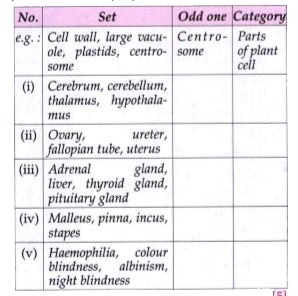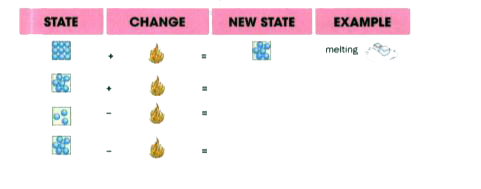Given below is a set with four terms. In each set a term is an odd one and cannot be grouped in the same category to which the other three belong. Identify the odd one in each set and name the category to which the remaining three belong. The first one has been done as an example:
Example : Fructose, Sucrose, Glucose, Calcium.
Odd term : Calcium
Category : Carbohydrates.
Saliva, bile, sweat, tears.
Step-by-Step Solution:
1. Identify the Terms: The terms provided are Saliva, Bile, Sweat, and Tears.
2. Analyze Each Term:
- Saliva: A digestive secretion that contains enzymes, including lysozyme, which helps in breaking down food and has antibacterial properties.
- Bile: A digestive fluid produced by the liver that aids in the digestion of fats but does not contain lysozyme.
- Sweat: A fluid secreted by sweat glands that helps in thermoregulation and contains lysozyme, which has antibacterial properties.
- Tears: A fluid produced by the lacrimal glands that lubricates the eyes and contains lysozyme, which helps in killing bacteria.
3. Determine the Odd One Out:
- Bile is the odd one out because it does not contain lysozyme, while Saliva, Sweat, and Tears all do.
4. Identify the Category for the Remaining Terms:
- The remaining three terms (Saliva, Sweat, and Tears) can be categorized as "Germ-killing secretions that contain lysozyme."
Final Answer:
- Odd term: Bile
- Category: Germ-killing secretions that contain lysozyme.
---
- Saliva: A digestive secretion that contains enzymes, including lysozyme, which helps in breaking down food and has antibacterial properties.
- Bile: A digestive fluid produced by the liver that aids in the digestion of fats but does not contain lysozyme.
- Sweat: A fluid secreted by sweat glands that helps in thermoregulation and contains lysozyme, which has antibacterial properties.
- Tears: A fluid produced by the lacrimal glands that lubricates the eyes and contains lysozyme, which helps in killing bacteria.
- Bile is the odd one out because it does not contain lysozyme, while Saliva, Sweat, and Tears all do.
- The remaining three terms (Saliva, Sweat, and Tears) can be categorized as "Germ-killing secretions that contain lysozyme."
- Odd term: Bile
- Category: Germ-killing secretions that contain lysozyme.
Topper's Solved these Questions
- SAMPLE PAPER 2013Book:ICSEChapter:SAMPLE PAPER 2013Exercise:SECTION-I (CHOOSE THE CORRECT ANSWER)
Explore 5 Videos
- SAMPLE PAPER 2013Book:ICSEChapter:SAMPLE PAPER 2013Exercise:SECTION-II
Explore 56 Videos
- SAMPLE PAPER 2012Book:ICSEChapter:SAMPLE PAPER 2012Exercise:SECTION-II
Explore 57 Videos
- SAMPLE PAPER 2014Book:ICSEChapter:SAMPLE PAPER 2014Exercise:SECTION-II
Explore 72 Videos
Similar Questions
Given below are six sets with four terms each. In each set a term is an odd one and cannot be grouped in the same category to which the other three belong. Identify the odd one in each set and name the category to which the remaining three belong. The first has been done for you as an example.

View SolutionGiven below are six sets with four terms each. In each set a term is an odd one and cannot be grouped in the same category to which the other three belong. Identify the odd one in each set and name the category to which the remaining three belong. The first one has been done as an example:
Example : Fructose, Sucrose, Glucose, Calcium.
Odd term : Calcium
Category : Carbohydrates.
Cretinism, myxedema, simple goitre, acromegaly.
View SolutionGiven below are six sets with four terms each. In each set a term is an odd one and cannot be grouped in the same category to which the other three belong. Identify the odd one in each set and name the category to which the remaining three belong. The first one has been done as an example:
Example : Fructose, Sucrose, Glucose, Calcium.
Odd term : Calcium
Category : Carbohydrates.
Sneezing, coughing, blinking, typing.
View SolutionGiven below are six sets with four terms each. In each set a term is an odd one and cannot be grouped in the same category to which the other three belong. Identify the odd one in each set and name the category to which the remaining three belong. The first one has been done as an example:
Example : Fructose, Sucrose, Glucose, Calcium.
Odd term : Calcium
Category : Carbohydrates.
Carbonic acid, acetic acid, benzoic acid, boric acid.
View SolutionGiven below are six sets with four terms each. In each set one term is odd and cannot be grouped in the same category to which the other three belong. Identify the odd one in each set and name the category to which the remaining three belong. The first one has been done as an example.
Example: Calyx, Corolla, Stamens, Midrib
Odd term : Midrib
Category : Parts of a flower.
Transpiration, Photosynthesis, Phagocytosis, Guttation.
View SolutionGiven below are six sets with four terms each. In each set one term is odd and cannot be grouped in the same category to which the other three belong. Identify the odd one in each set and name the category to which the remaining three belong. The first one has been done as an example.
Example: Calyx, Corolla, Stamens, Midrib
Odd term : Midrib
Category : Parts of a flower.
Haemoglobin, Glucagon, lodopsin, Rhodopsin.
View SolutionGiven below are six sets with four terms each. In each set one term is odd and cannot be grouped in the same category to which the other three belong. Identify the odd one in each set and name the category to which the remaining three belong. The first one has been done as an example.
Example: Calyx, Corolla, Stamens, Midrib
Odd term : Midrib
Category : Parts of a flower.
Oxytocin, Insulin, Prolactin, Progesterone.
View SolutionIdentify the odd one in each set and name the category to which the remaining three belong :
Semicircular canals, Cochlea, Tympanum, Utriculus.
View SolutionIdentify the odd one in each set and name the category to which the remaining three belong :
Aqueous humour, Vitreous humour, Iris, Central canal
View SolutionComplete the table given below . (The first one has been done as an example )

View Solution

